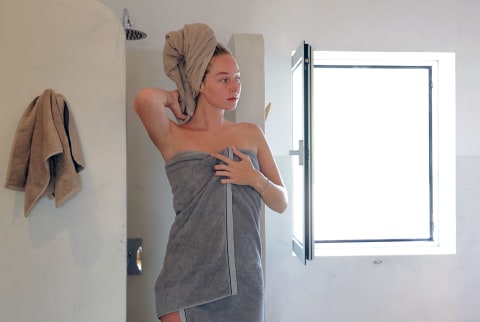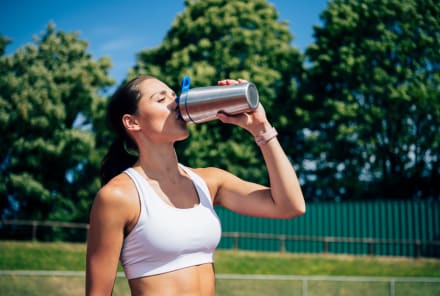Advertisement
Are Cold Showers Good For You? The Research + Expert Advice

Hannah Frye is the Assistant Beauty Editor at mindbodygreen. She has a B.S. in journalism and a minor in women’s, gender, and queer studies from California Polytechnic State University, San Luis Obispo. Hannah has written across lifestyle sections including health, wellness, sustainability, personal development, and more.


These days, ice baths and cold plunges are basically synonymous with the well-being industry, and many people use them as a biohacking staple for more energy, less anxiety, and heightened recovery. But while cold plunging may be life-changing for some, it’s certainly not accessible for all. This begs the question—can we get the same benefits from just hopping in a cold shower?
Here's our investigation on whether cold showers are good for you, and how they compare to more immersive cryotherapy tools like ice baths.
The need-to-knows
- Cold therapy is a hot topic: Cryotherapy (exposure to extreme cold) does seem to have benefits related to circulation, mood, and metabolism, but the research is still early.
- Cold showers totally count as cryotherapy—as long as they're cold enough: Make sure yours is between 50° to 59° Fahrenheit (10° to 15° Celsius).
- There are some risks associated with cold showers: Listen to your body and don't stay in a cold shower for more than a few minutes to avoid unwanted side effects like hypothermia.
The benefits of cryotherapy
It enhances circulation
“Cold exposure prompts an intense and immediate vasoconstriction followed by vasodilation, improving blood flow throughout all the organs,” says longevity expert and physician Darshan Shah, M.D.
This could be one of the reasons people seek out cold plunging for assistance in exercise recovery. (Cold does seem to reduce muscle soreness, though it's unclear if it benefits overall muscle function1.)
Still, improving circulation is beneficial for overall health. By improving blood flow in the body, you’re assisting the natural process of bringing fresh blood and oxygen to your organs, encouraging them to function optimally.
It may improve mental health (at least in the short term)
“Cold therapy can increase levels of norepinephrine, a neurotransmitter associated with vigilance, focus, and mood elevation,” Shah says. Taking a cold shower is an example of hormesis, or exposing yourself to short-term stress in order to help the body and mind become more resilient over time.
One 2023 study published in the journal Biology suggests that short-term, whole-body cold emersion may have integrative effects on brain functioning2, contributing to the reported improvement in mood. In those who participated, the after-effects of a cold bath included feeling more alert, attentive, proud, and inspired, while feeling less distressed and nervous.
However, this benefit will likely vary from person to person. Some may find the cold therapy more stressful in the moment than it’s worth for them.
It may boost metabolism
“Exposure to cold can increase metabolic rate and activate brown adipose tissue, aiding in weight management,” Shah notes.
One 2022 study published in the International Journal of Circumpolar Health backs up this claim. Researchers state, “[Cold water emersion] seems to reduce and/or transform body adipose tissue3, as well as reduce insulin resistance and improve insulin sensitivity.”
These benefits combined may have a protective effect against cardiovascular, obesity, and other metabolic diseases and could have an overall disease-prevention effect, researchers explain.
It can encourage a breathwork practice
Many cold plunging experts, such as "The Iceman" Wim Hof, call on the power of breath when facing frigid waters.
On a previous episode of the mindbodygreen podcast, Hof explained that breathing is actually the most important part of cold exposure. Breath teaches you how to regulate stress in your body and your mind, and stay calm in extreme conditions, he explained.
The more you expose your body to the cold and breathe through it, the more likely you may be to rely on breath during other stressful situations.
For this reason, cryotherapy can also be seen as a mindfulness activity. For the time you’re exposed to the cold (be it 5 seconds or 5 minutes), the cold temperature will essentially shock your mind into the present moment, which can be helpful for some who find it difficult to center themselves without external support.
It could help promote longevity
“While direct links to longevity are complex and multifaceted, cold therapy's potential to reduce inflammation and stress at the cellular level might contribute to longer, healthier life spans,” Shah explains.
Rather than seeing cryotherapy as a one-way ticket to a longer life, view it as one of the many tools that can support your mind and body as you age.
It has beauty-related perks
Cryotherapy can positively impact the health and appearance of hair and skin, too. Cold water seals down the hair cuticles and helps lock moisture into the strands themselves (plus, it helps the scalp retain its moisture since hot water can famously strip its precious oils). "The cool water temperature closes and strengthens the hair cuticle, which can result in stronger, healthier hair over time," celebrity hairstylist Andrew Fitzsimons previously told mindbodygreen.
Cold (or hot) immersions can also be beneficial for those with inflammatory skin conditions like rosacea, eczema, and acne. (Just note that hot water can have a drying effect on the skin, and result in flushing, which may be more pronounced on those already struggling with redness.)
Are cold showers enough to stimulate these benefits?
Some research related to cold water immersion is specifically focused on cold plunging and staying submerged in cold water or a cold chamber for a few minutes. Other studies, however, have shown that cold showers are also a legitimate cryotherapy method.
Mark Harper, M.D., Ph.D., a cold therapy expert and consultant anesthetist at Sussex University Hospitals, agrees with the sentiment that cold water emersion is inclusive of showers, too.
“You’re going to have the same effect as getting in the sea really [or the lake or pool] with the shower. You’re not getting cold as quickly, so it’s just coming on gradually,” he said on a previous episode of the mindbodygreen podcast.
Mutahir Farhan, M.D., an internal medicine physician and member of The Vitamin Shoppe’s Wellness Council agrees, but notes the setting is important. You need to make sure you have access to a heat source after stepping out in order to bring the body’s core temperature back to a normal range. Otherwise, a cold shower (or cold plunge of any kind, for that matter) isn’t suggested—that’s a recipe for hypothermia.
Summary
How cold does it need to be?
“The optimal temperature for cold therapy is generally between 50° to 59° Fahrenheit (10° to 15° Celsius),” Shah suggests, adding, “This range is effective for eliciting the cold shock response without posing a significant risk to health.” You can let some water flow into a cup and measure it with a thermometer for an exact reading.
Shah calls out that individual responses to cold can vary based on factors such as sex, body composition, acclimatization levels (i.e. how often you expose yourself to cold), and personal health, so adjustments in temperature may be necessary.
For example, exercise physiologist and nutrition scientist Stacy Sims, Ph.D. noted on a previous episode of the mindbodygreen podcast that women begin to shiver sooner than men. Thus, they can keep their cold plunge at a temperature on the higher end of the spectrum, around 55° or 56° Fahrenheit.
Of course, the exact temperature you choose will also depend on how long you plan on staying in—if you're taking a shorter shower, you may be able to handle a colder temperature.
Regardless of the method, be it shower or plunge, Farhan suggests starting slow. You can begin cold therapy at the top of this ideal range and gradually go cooler and cooler as you begin to get used to it over time (and remember to breathe!).
Summary
How long do I need to stay in?
There is no universal recommendation for how long to stay in a cold shower—it depends on your goals. One study found that around 10 minutes of cold exposure is ideal for muscle recovery4 if you’re in that ideal range between 50° to 59° Fahrenheit. For brain health benefits, you may not need to exceed five minutes2. Other protocols say that 2-3 minutes in a cold shower is plenty. Gradually work up to these times and keep your showers shorter if that feels better for your body.
Alternating between hot and cold water can make the experience more pleasurable—and it might come with enhanced circulation perks, Shah notes. Should you decide to go back and forth between hot and cold therapy, it’s best to end on cold to allow your body to naturally warm up via thermogenesis.
Summary
How often do I need to take them?
The best cadence for cold showers depends on the benefits you seek and your personal response to them. Here are a few instances where hopping in a cold shower might be helpful:
- For mood support, instant benefits have been documented4—suggesting that the occasional shower to alleviate negative emotions is worth considering, even if you don’t want to commit to a daily practice.
- For optimal exercise recovery, taking a cold shower (or ending your warm shower on cool for a few minutes) is worthwhile after tough workouts.
- Hopping in a cold shower may also help patients in menopause who suffer from hot flashes—at least anecdotally. "Unfortunately, there is no strong medical study that has looked into this,” Farhan caveats.
- People with a mild fever may also experience relief from a cold shower, Farhan notes. “If the fever is not responding to medications, it might be beneficial to try a cold shower but usually at that point you should be talking to a physician and getting assessed in person."
The bottom line is that, like many things in the world of well-being, you should do what makes you feel your best. If you notice you feel much better, physically or mentally, after a cold shower, then why not work it into your routine daily?
Is there a best time to take cold showers?
In the morning, cold exposure can make you feel more awake and energized. However, cooling the body before bed does signal the brain to release the hormone melatonin5 (hence, why experts suggest sleeping in a cool room). There are benefits to both times, so pick whichever works best for you.
Other perspectives on cold showers
In general, cold showers are a pretty safe well-being practice to try. That being said, you shouldn't use them as your only tool for mood regulation, energy, recovery, or any other benefit. You’d be wise to use cold therapy of any kind alongside complementary health practices.
Cold showers likely won't come with significant longevity benefits on their own. To promote a long, healthy life, dial-in on your nutrition and exercise plan first, and let the additional routines come next. Cold therapy can build on your existing practice, but won’t substitute for the basic pillars of well-being.
Risks & side effects
If you are pregnant, breastfeeding, or have a heart condition, it’s best to skip cold showers until you get the okay from your physician. Farhan notes that some people with asthma may want to be wary as well, as a cold shower might exacerbate those symptoms. 3Folks with Raynaud’s syndrome and other circulation issues may want to avoid cold therapy too.
Every expert interviewed for this story stressed the importance of listening to your body when doing cryotherapy and exiting the shower or bath when you begin to feel adverse side effects (light-headedness, dizziness, or any kind of pain). Prolonged exposure can lead to hypothermia, so take the timer seriously and work your way up.
Keep your water in the ideal temperature range (50° to 59° Fahrenheit) and limiting showers to 10 minutes maximum should reduce your risk of hypothermia. Ease into lower temperatures if you're new to the practice.
Since cold showers are stressors, you might also want to avoid them when you are going through intense periods where your cortisol is already running high. Again, listen to your body.
The mindbodygreen POV
Cold exposure is a great example of a hormetic stressor that can benefit the inflammatory response, sleep, metabolism, and more. If you don't have access to a fancy ice bath or cryotherapy chamber, you can achieve some of the benefits of cold exposure by just taking a cold shower at home.
Just make sure that the water is cold enough, and engage your breath throughout to make the cold more bearable. Practice proper safety protocols to ensure that your cold shower stays good for you and doesn't veer into potentially dangerous territory.
—Emma Loewe, mindbodygreen health & sustainability director
FAQ
Is it okay to take a cold shower everyday?
Yes, it is okay to take a cold shower every day. However, you should keep the temperature between 50° to 59° Fahrenheit (10° to 15° Celsius).
What are the disadvantages of cold showers?
Cold showers are uncomfortable and can lead to hypothermia if not done properly. You should ask your doctor before committing to a regular cold shower practice if you are pregnant, breastfeeding, or have a heart condition of any kind.
Are cold showers good for your hair?
Yes, cold showers are good for your hair. Cold water seals down the hair cuticles and helps lock moisture into the strands. You can reap these benefits by rinsing your hair with cool water at the end of an otherwise warm shower as well.
The takeaway
The research on cold shower benefits is minimal, but promising. There have been documented benefits related to mood, circulation, muscle recovery, hair health, and more. However, there are risks to taking a cold shower that is too cool and staying in for too long, so keep that in mind if you decide to try it out. If you’d rather take a chilly bath, check out our favorite cold plunge tubs on the market.
Watch Next
Enjoy some of our favorite clips from classes
Enjoy some of our favorite clips from classes
What Is Meditation?
Mindfulness/Spirituality | Light Watkins
Box Breathing
Mindfulness/Spirituality | Gwen Dittmar
What Breathwork Can Address
Mindfulness/Spirituality | Gwen Dittmar
The 8 Limbs of Yoga - What is Asana?
Yoga | Caley Alyssa
Two Standing Postures to Open Up Tight Hips
Yoga | Caley Alyssa
How Plants Can Optimize Athletic Performance
Nutrition | Rich Roll
What to Eat Before a Workout
Nutrition | Rich Roll
How Ayurveda Helps Us Navigate Modern Life
Nutrition | Sahara Rose
Messages About Love & Relationships
Love & Relationships | Esther Perel
Love Languages
Love & Relationships | Esther Perel
What Is Meditation?
Box Breathing
What Breathwork Can Address
The 8 Limbs of Yoga - What is Asana?
Two Standing Postures to Open Up Tight Hips
How Plants Can Optimize Athletic Performance
What to Eat Before a Workout
How Ayurveda Helps Us Navigate Modern Life
Messages About Love & Relationships
Love Languages
Advertisement

This Type Of Fat Is Vital For Women's Health — Are You Getting Enough?
Molly Knudsen, M.S., RDN

New Study Confirms The 3 Habits That Age Your Brain Faster
Molly Knudsen, M.S., RDN

This Type Of Fat Is Vital For Women's Health — Are You Getting Enough?
Molly Knudsen, M.S., RDN

New Study Confirms The 3 Habits That Age Your Brain Faster
Molly Knudsen, M.S., RDN













